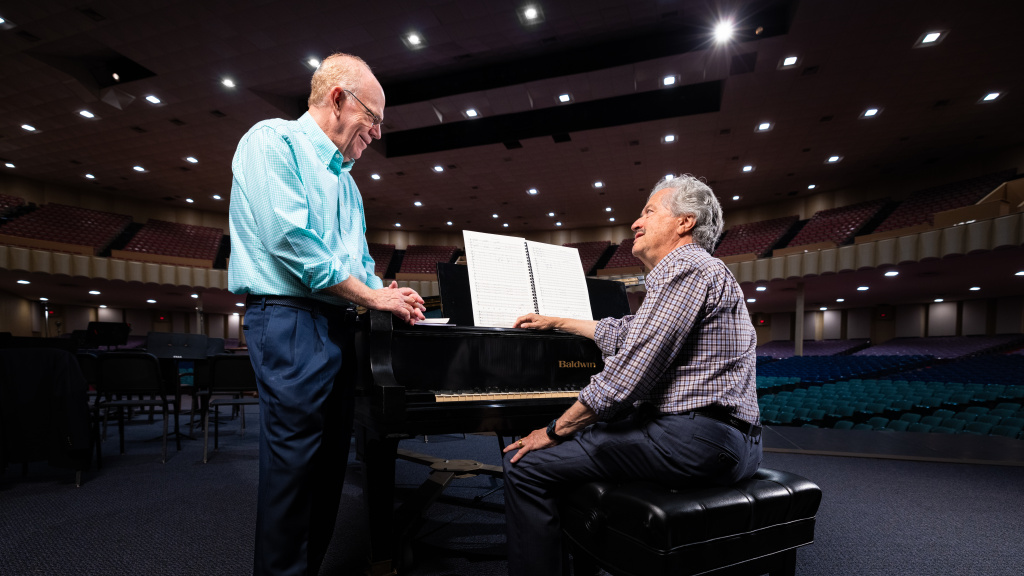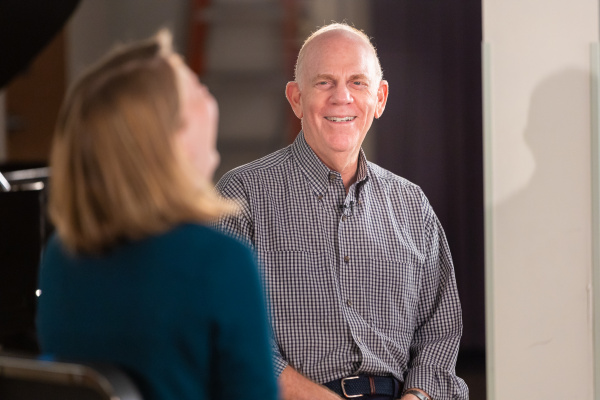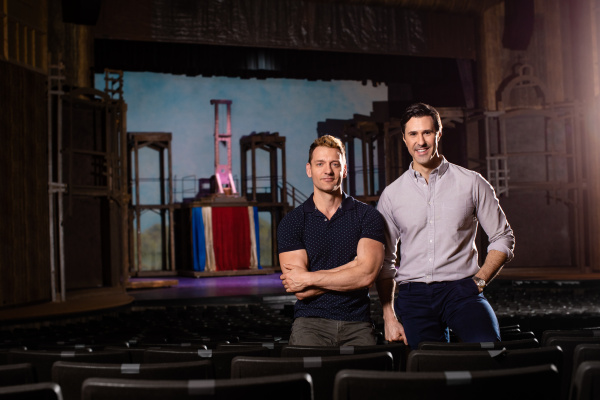Composer Lee Holdridge (seated) with conductor Richard Kaufman
Imagine watching a movie with no sound. On the screen, a shark swims in the shallows. Not so scary. Add two iconic notes, and you now have a scene from a film that has scared many away from shores across the nation.
“Jaws scared the daylights out of the audience,” said Lee Holdridge, composer of other film and television scores. “We did an exercise years ago in a classroom. We took the film and didn’t play the music. I said, ‘What do you see?’ And they said, ‘A lot of seaweed.’ … Put that music to it, and all of a sudden your subconscious says, ‘Wait a minute. There’s danger around here.’ ”
This is the magic Holdridge works when he is presented with a feature film or television show to score. The award-winning composer hasn’t limited himself to the film industry, however. He has also written multiple operas and concert pieces.
One of his most recent concert pieces, Fantasy Chorale: A Journey of Joy and Hope, was written as a gift to Bob Jones University and will be premiered during Symphonic Hollywood: Featuring the Music of Lee Holdridge at 7:30 p.m. on Oct. 7 in Founder’s Memorial Amphitorium. Holdridge and Richard Kaufman will be guest conductors.
For tickets, call Programs and Productions at (864) 770-1372 or visit the website.
Off to a Late Yet Rapid Start
Though Holdridge didn’t begin music lessons until he was 10 years old, he was composing by 12. His first compositions were a result of boredom. “I started by rewriting my violin exercises,” he said. “I drove my violin teacher nuts.”
Growing up in Costa Rica, Holdridge took lessons from Hugo Mariani, the conductor of the national symphony orchestra. “(He) was a phenomenal violinist,” Holdridge said. “He was my very first music teacher and an extremely important one because I learned so much of the basic music from him.”
It was while he was attending high school in Boston that Holdridge met his favorite music teacher, Henry Lasker. Lasker not only taught Holdridge violin and composition but also a drive to make his music the best it could be. Holdridge said, “Every now and then, I feel him standing over my shoulder when I’m working on something. I turn around and look, and he shakes his head. … I say, ‘OK, I’ll work on it some more.’ ”
A Modern Renaissance Man
Holdridge has a diverse repertoire. After arriving in New York, he began to work with recording studios. “In those early days — that’s early ‘60s — was when I started doing a lot of recording and writing songs,” he said. “I wrote a lot of different things. I wrote ballets. I wrote for the theatre. I wrote concert works. I was a real Renaissance man. I still am.”
In addition to ballet, theatre and concert pieces, Holdridge has written for individual artists such as Neil Diamond, John Denver, Barbra Streisand and Whitney Houston as well as film and television scores — winning a Grammy nomination for the title song for the series Moonlighting and a Grammy award and two Emmy awards for his score for the CBS series Beauty and the Beast — and opera. “I don’t want to get pigeonholed into any one thing, and I think my concert reflects that. It reflects all the different areas that I’ve been involved in.”
Catching up with Old Friends
Symphonic Hollywood: Featuring the Music of Lee Holdridge is the second concert of its kind conducted at BJU by Richard Kaufman. “I’ve known Richard for a long time,” said Holdridge. “When I started out doing my first early scores at Universal Television, Richard was in the orchestra playing the violin.”
The friends of five decades join forces as guest conductors in the concert in Founder’s Memorial Amphitorium. Highlights of the event include a suite compilation of Holdridge’s Hymns Triumphant. “The first half will close with a piece that Lee has written especially for this concert called Fantasy Chorale: A Journey of Joy and Hope for the orchestra and chorus, and it will be a world concert premiere,” said Kaufman.
Holdridge said the new concert piece started with a chord sequence that played in his head over and over. “I was intrigued with it.” When asked by those planning the concert if he would consider writing a piece, he believed he found a use for the persistent musical phrase. “That started from there and just kept growing,” he said.
How to Follow His Footsteps
While on campus, Holdridge and Kaufman will be speaking in seminars, masterclasses and forums for BJU students. “I’m not a teacher,” said Holdridge, “but I’ll be happy to share experiences with the students and, actually, encourage them to ask questions.”
In the meantime, Holdridge did have some advice for those who are pursuing a career in composition.
First, study how music works. “The most important thing I think you can do is to, actually, really study composition,” he said. “It’s an invaluable tool.” He compared a musical composition to a novel. Just as a novelist should know how words work together to form sentences, paragraphs and chapters, a composer should know how notes work together to form chords and phrases and movements.
One of Holdridge’s favorite pieces of advice he likes to give students: “When they come to you and say, ‘Can you write this?’ Say yes. Say yes because you can always find out how to write that.” Once, someone asked him to compose an arrangement for two pianos, something he had not yet done. “I went home that night, and I studied two-piano music. … I wrote these two-piano arrangements for him, and he loved them, and he hired me every year to do more.
“So always say yes. Always open the door. Don’t close it. Don’t say, ‘Oh, I can’t do that now.’ … Always stretch. Always reach. Always go beyond where you’ve gone before, and that’s going to come in your favor.”
Mr. Lasker would agree.








